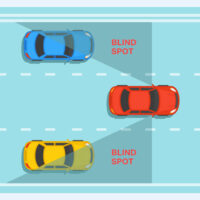Blind Spot Accidents

When you get behind the wheel of a vehicle, you need to remember one thing: All vehicles have blind spots. Blind spots refer to areas around a vehicle that a driver cannot easily see. When you think of blind spots, you may think of semi trucks, but the truth is that all vehicles have them. Typically, they can be found on the sides of the vehicle as well as the edges directly behind the car or truck. However, this can vary by vehicle based on the design, so blind spots can show up anywhere and block a driver’s vision.
Not correctly checking your blind spots can lead to a car accident. Sideswipe accidents are especially common. Blind spot accidents typically happen when a driver attempts to turn, change lanes, or merge into an adjacent lane. These crashes are common on highways, where frequent lane changes and high speeds increase the risk of blind spot accidents. They are also common on urban roads since dense traffic and numerous intersections can lead to more vehicles being in blind spots. They may occur in parking lots as well, since the presence of pedestrians, parked cars, and tight spaces creates more blind spots.
Causes of Blind Spot Accidents
Blind spot accidents may be caused by the following:
- Not checking blind spots. You cannot rely solely on your car’s mirrors. Drivers may neglect to manually check blind spots by turning their head before changing lanes or merging.
- Improper use of mirrors. While you should use mirrors, they need to be used properly. Failing to adjust side and rearview mirrors properly reduces visibility.
- Lack of awareness. Drivers may not be aware of the extent of their vehicle’s blind spots, which can be large, especially in trucks and SUVs.
- High traffic density. In heavy traffic, vehicles are more likely to be in each other’s blind spots.
- Sudden lane changes. Quick lane changes without signaling can lead to collisions with vehicles in the blind spot.
Identifying Blind Spots
Knowing how to identify blind spots is crucial for new drivers. If you are a parent of a teen, help them learn about blind spots by practicing identifying them. With the vehicle off and the windows down, put your teen in the driver’s seat and stand toward the back of the vehicle. Move slowly behind the vehicle to show your teen how you can disappear from view in the vehicle’s mirrors.
Keep in mind that blind spots never really go away, so teach your teen how to look for them. Practice what you preach by checking your mirrors and looking over your shoulder before merging, turning, or changing lanes.
Contact Us Today
Blind spots can be a major contributor to car crashes. Drivers need to make sure they are looking in all directions before merging and making lane changes.
The Kissimmee auto accident lawyers at Draper Law Office can assist you with your crash case. We can help you in the recovery of property damage to your vehicle, as well as for medical bills, lost wages, pain and suffering, and more. Schedule a free consultation today by filling out the online form or calling (407) 743-6628.
Source:
nsc.org/road/safety-topics/before-your-teen-begins-driving/lesson-10-blind-spots






